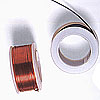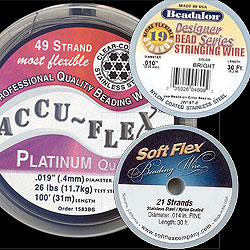Beading Wire vs Jewelry Wire
Beading wire is not the same thing as jewelry wire.
Jewelry wire is just a single strand of wire often made of brass or copper. Jewelry wire is most often used for sculpting and wire wrapping.
 Beading Wire, like Tigertail, is made up of multistrands of very fine steel cables and usually twisted together. These multistrands are then coated with plastic or nylon, which can come in a variety of colours. The coating creates a tough and resilient beading wire. Beading wire is normally used for stringing beads.
Beading Wire, like Tigertail, is made up of multistrands of very fine steel cables and usually twisted together. These multistrands are then coated with plastic or nylon, which can come in a variety of colours. The coating creates a tough and resilient beading wire. Beading wire is normally used for stringing beads.
Among the more well known brands of beading wire are from Beadalon, Soft Flex, and Accu Flex. Often to differentiate between beading wire and metal/jewelry wire, the former is often referred to by their brand or trade name rather than in its generic term.
Jewelry Wire: Diameter or Gauge
 Jewelry wire is measured and sold according to its gauge. This is a measure of the diameter of the wire. However contrary to expectations, the smaller the gauge size, the larger the diameter.
Jewelry wire is measured and sold according to its gauge. This is a measure of the diameter of the wire. However contrary to expectations, the smaller the gauge size, the larger the diameter.
Wire gauges can be a bit confusion as they seem an almost arbitrary number. Review the Wire Gauge conversion chart as a guide in choosing the right diameter.
Beading Wire/Tigertail: Strand Count
Beading wire like Accu-Flex Professional Quality Beading Wire is actually made up of tiny strands of wire. What is even more interesting about these wires is that each strand is itself made up of multi-strands of micro-fine strands of wire. So a beading wire that has seven (bundles of) strands of wire, and each bundle has 7 micro-strands, then there are in effect 49 individual strands of wire all together; this is the strand count. And as you would expect, the higher the number of strands in the wire, the better it will hold up to abrasion.
You would want to work with a higher strand count if you are working with rougher stones or those that have a potential of wearing down the stringing material used.
Because of all the multiple strands of micro-strands of wire, some of the beading wires are so soft and flexible, they can actually be knotted. But it is still much more professional looking to finish them with crimps (French crimps).
As a rough general guide:
- for an all purpose stringing wire, the 49 strand and 0.19mm diameter wire is recommended.
- for lightweight materials (like pearls and gemstone beads), use the 40 strand, 0.14mm diameter beading wire.
- for big beads, heavy beads, or those that may have rough edges, the 49 strand, 0.24mm diameter wire would be a recommended choice.
As all these beading wire, as well as tigertails, come in a variety of colours, you have a very wide selection to add colour, interest, and variety in your work.
Tigertail (also sometimes spelt Tiger Tail) is really a kind (subset) of beading wire. Tigertails are also made up of multi-strands of fine stainless stell wire and coated with plastic or nylon. They are resilient and durable. They are much less expensive than the branded beading wires and are an excellent multipurpose thread. Tigertail is used when strength is a priority. It is best with heavy beads. It is not recommended for use with pearls nor for light-weight beading projects.
On the negative side, they kind easily and does not have a soft fall/drape. To end off tigertail, crimps are the best. It should not be tied/knotted as a means of ending a piece of tigertail beadwork.

I have an older spool of 12lb tigertail and have no idea what that is in gauge or diameter. Can you help me figure it out?
Hi there Tiquatue, I am not sure I can give you any definitive answer. I don’t often see tigertail in terms of gauges; rather the number of strands of wire that go to make up that particular tigertail. Gauge just measure the thickness. So you could use a caliper to measure the diameter of your tigertail to determine its gauge/diameter.
Good luck.